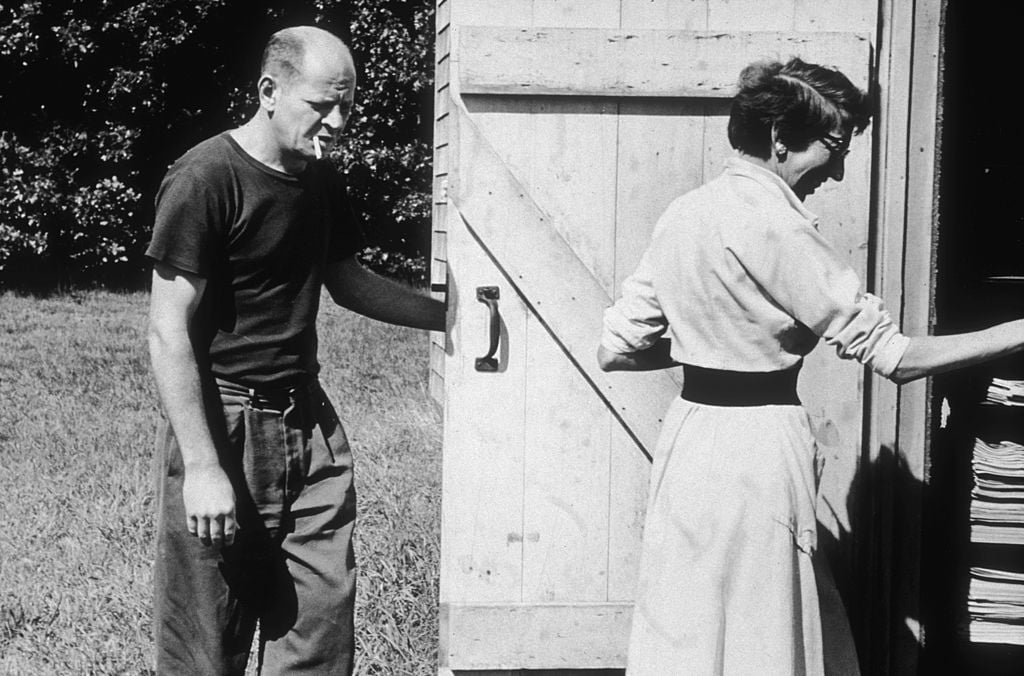
A group of poorly executed fake Jackson Pollock paintings with a bizarre backstory has ensnared at least three buyers—and potentially more, according to an investigation by the International Foundation for Art Research (IFAR). While recent high-profile forgery scams have fooled wealthy and seasoned collectors, this latest one takes aim at unsophisticated actors in the middle market.
The story, first reported by the Art Newspaper, follows the usual art scam storyline: A group of never-before-seen works mysteriously surface, all from the same source, with a strange but too-good-to-be-true origin story. In this case, the cache of Pollocks supposedly came from a mentally unstable and reclusive German immigrant named James Brennerman who left them to his servants when he died. At least two of the paintings were purchased from a strip club owner in Roanoke, Virginia, who said he got them from the servants, according to IFAR.
The foundation’s take? Brennerman is a fictitious identity and the works are “unconvincing.”
The outlandish tale is outlined in the latest edition of the IFAR Journal. “Given the potentially large number of paintings involved and their wide circulation throughout the US, IFAR feels compelled to share what it has learned and put the public on notice about this apparent and audacious scam,” Sharon Flescher, IFAR’s executive director, and Lisa Duffy-Zeballos, IFAR’s art research director, write.
Photo: Courtesy International Foundation for Art Research (IFAR).
Three different owners submitted four works to the foundation in 2013 and 2014, all of which were deemed fake. (Since the Pollock-Krasner Foundation disbanded its authentication arm in 1995, IFAR sometimes examines and rules on Pollock works.)
The scam doesn’t end there, however. “Alarmingly, we already know that at least one of the four works we rejected has been resold to an apparently unsuspecting buyer,” Flescher and Duffy-Zeballos write.
In addition to the four it has examined, IFAR has seen images of roughly ten other purported Pollock works from the same source that it believes are fake. One of the owners said he personally owned more than 50 Brennerman “Pollocks” and hundreds of works by other artists from the same source.
The scam appears to have been aimed at modest collectors and is emerging in the Mountain States and along the East Coast amid “a whole network of people who are not professional dealers, a different world from what we’re used to,” Flescher told TAN. Because the prices are relatively low—in the five figures—and involve less sophisticated buyers, they can circulate more easily, she says.
Buyers were told that Brennerman settled in Chicago in the 1940s, and paid cash to acquire roughly 750 paintings directly from the artist’s widow Lee Krasner in 1968. (“The suggestion that Lee Krasner would have sold over 700 Pollocks, more than half of his known output, wholesale for cash, simply defies belief,” Flescher and Duffy-Zeballos write. “There were not that many Pollocks in the artist’s possession when he died.”)
The notion that Brennerman became mentally unstable was used to explain why the works were never displayed publicly and were instead willed to his servants. The foundation says that documents and photographs provided by the owners to back up the story are dubious at best, including a photograph of Brennerman’s Chicago mansion that is, in fact, an image of the Sforza Castle in Milan, Italy.
Although IFAR found the paintings unconvincing and the backstory “sometimes laughable,” it nonetheless subjected the works to scientific analysis. The tests were performed by the lab of a major American museum and the works were also examined by a conservator, Flescher told artnet News.
Results showed that the paintings were created with anomalous materials, such as acrylic paint that has never appeared in any accepted Pollock work and which was not widely available until the 1980s. Pollock died in a car crash in Eastern Long Island in 1956.